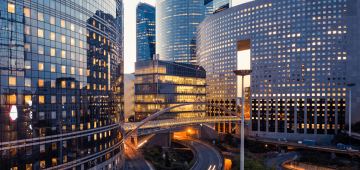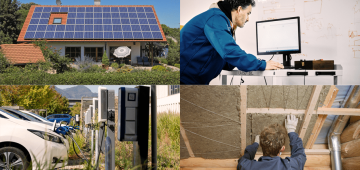Jul 2021
The main sources of energy savings
In buildings used by businesses and communities, the sources of energy savings depend above all on the way the buildings are operated. Industrial buildings and factories are obviously more energy intensive than tertiary sector buildings.

In buildings used by businesses and communities, the sources of energy savings depend above all on the way the buildings are operated. Industrial buildings and factories are obviously more energy intensive than tertiary sector buildings. However, there are always multiple ways of saving energy in all areas: heating, air conditioning, water, lighting, industrial processes, etc. These areas must therefore be identified for solutions to be found and to optimise overall consumption while also lowering the utilities bill.
Defining sources of energy savings
As with one's bank account, spending less energy can be done by being mindful and finding alternative solutions. This means using resources in a more reasoned way while also maintaining comfort (learn more about the concepts of energy efficiency and energy performance).In industrial and tertiary-sector buildings and in homes, saving energy can be done in different ways. For each building, identifying the sources of potential savings can be useful to understand why they are so energy-intensive in the first place. Decreasing a building’s energy consumption can also be done with the help of innovative energy management tools.
What are the sources of energy savings in buildings?
A building’s energy consumption can be divided into three main categories:
- Heating, ventilation and air conditioning (abbreviated as HVAC);
- The use of water;
- electricity.
For any type of building, lowering consumption in these three categories can be done by changing habits and by installing measuring devices.
Heating, ventilation and air conditioning (HVAC)
Buildings must be heated in the winter time and they often have to be refrigerated in the summer to remain habitable. And throughout the year, these buildings must remain ventilated. In corporate and collective buildings, these three consumption areas are generally the most expensive. But there are many ways to save energy, through construction or renovation work, and through quicker solutions.
During construction, priority must be placed on insulation – to preserve heat and coolness – and on ventilation. Different solutions exist in these areas, such as the insulation of roofs, external walls and floors. When the existing building is already in place, undertaking renovations can help limit the loss of heat in the winter and reduce the impact of solar radiation in the summer.
If such work can be done, installing solar panels on the roofs can be very profitable, as energy can be retrieved and re-distributed. In the context of the smart city, sun rays can now be wielded from the asphalt when the pavement is equipped with sensors. Heat is then stocked and re-distributed inside the building in winter. Conversely, when the sunlight hits the windows and leads to air conditioning being turned on, there is the option of having smart and energy-efficient window blinds that detect sunlight and that are lowered automatically to limit heat from entering.
More directly, all users of a building can be asked to be mindful of their energy use and to limit it by various means. This can start, for example, by turning off the heat in empty or rarely occupied rooms. Connected sensors can now detect rates of presence and room temperature to help regulate these factors.
Water
Depending on the type of building, the use of water, and hot water in particular, can lead to high expenses. In buildings that host tertiary-sector, industrial or administrative activities, a lot of water is consumed in places like the lavatories, the restaurant / cafeteria, and by the regular cleaning services.
There too, if everyone is more careful, water use can be limited. However, not everything can be attributed to direct consumption. Other areas must be explored to limit water flow. The first step is to detect leaks and equipment breakdowns: anything that generates water waste before reaching the public. With the help of sensors and an online dashboard, being aware of water flow in real time can be effective in the long-term.
Electricity
In tertiary-sector buildings, the consumption of electricity is often higher than the actual needs of the people who work there. A computer, for example, does not need to stay on all night. The same goes for office buildings that stay lit once the employees have gone home.
Everyone must therefore make an effort. But, it can be even better to help users lower their consumption without them even realising it. And, that way, all of the responsibility isn’t placed on them. There again, presence-detecting sensors control lighting based on presence and lighting needs. Lights can be turned on, turned off, or adjusted. After being idle for a certain amount of time, computers can also turn off automatically. This can be done by changing the computers' settings and generalising this habit to all workstations.
Energy management: what are the solutions?
Before finding ways to save energy, starting by knowing the building's current energy consumption is a good start. That's what the energy audit is for. Large companies have to undertake it, smaller ones don't. And yet, smaller businesses can benefit from measuring their consumption to save money in the short and long terms.
The audit allows you to know your baseline consumption and it provides a framework to lower it. Large budgets and hard work are required to complete comprehensive audits where each area is analysed in detail. But if you are just embarking on the sustainable development journey, or if you want to save money relatively quickly, you can start with a simple, remote and cost-efficient energy audit. With this audit, you'll be able to swiftly assess the situation and see which areas are most energy intensive. The audit also provides steps to implement quick solutions, such as controlling the consumption of your buildings in real time. Heating, air conditioning, water and electricity are therefore continuously monitored.
If you want to delve further into energy savings, you can also look into energy management by assigning someone from your team to be an energy manager or by finding an external company to execute this mission. You will, in any case, have access to a real-time dashboard with precise statistics on the energy consumption of your buildings, as well as on potential waste and breakdowns. You'll have a reliable tool to measure and lower your energy consumption quickly.
Energy savings can be made by changing people's behaviours and by inspecting the equipment. When combining these two aspects, and with the help of new technologies specialised in precise energy management, energy consumption can be brought down without sacrificing user comfort. Identifying the details of your current consumption is the first concrete step towards saving more energy.
Picture by Natalya Letunova on Unsplash
Last news



